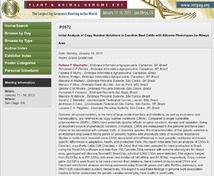Initial analysis of copy number variations in canchim beef cattle with extreme phenotypes for ribeye area.
Initial analysis of copy number variations in canchim beef cattle with extreme phenotypes for ribeye area.
Autoria: GIACHETTO, P. F.; PEREIRA, F. C. P.; MOKRY, F. B.; HIGA, R. H.; MUDADU, M. A.; SILVA, M. V.; NICIURA, S. C. M.; CARDOSO, F. F.; ALENCAR, M. M.; MEIRELLES, S. L. C.; LIMA, A. O.; REGITANO, L. C. A.
Resumo: Genomic structural variation, in the form of large-scale insertions and deletions, as well as inversions and translocations, are referred to as copy number variations (CNVs). Compared to single nucleotide polymorphisms (SNPs), CNVs have potentially greater effects on gene structure, dosage and regulation, being an important source of phenotypic variation. In humans, CNVs are widespread in the genome and have been shown to be associated with complex traits. In livestock species, the characterization of this genetic variation is an important step toward linking genes or genomic regions with phenotypic traits of economic importance. Studies in cattle have revealed some CNVs associated with differences in host parasite resistance and breed-specific differences in adaptation, health, and production traits. We report initial data from an analysis of CNVs in Canchim, a synthetic cattle (5/8 Charolais + 3/8 Zebu) that has been selected for meat production in Brazil. Using the PennCNV software and data from 192 Canchim DNA samples with extreme phenotypes for ribeye area, genotyped with Illumina BovineHD BeadChip, a total of 6,985 CNVs were detected. The regions ranged from 20,012bp to 4,157,122bp, with mean and median of 140,484bp and 81,303bp, respectively. Copy number gains (62.09%) were found to be more common than deletions. Gene content of discovered CNVs and functional enrichment analysis are being assessed using Ensembl genes and cattle RefSeq databases, and PANTHER classification system, respectively. We expect to use these findings in genome wide association studies to better understand the genetic variation underlying meat quality in beef cattle.
Ano de publicação: 2013
Tipo de publicação: Resumo em anais e proceedings
Unidade: Embrapa Agricultura Digital
Observações
1 - Por padrão são exibidas publicações dos últimos 20 anos. Para encontrar publicações mais antigas, configure o filtro ano de publicação, colocando o ano a partir do qual você deseja encontrar publicações. O filtro está na coluna da esquerda na busca acima.
2 - Para ler algumas publicações da Embrapa (apenas as que estão em formato ePub), é necessário ter, no celular ou computador, um desses softwares gratuitos. Sistemas Android: Google Play Livros; IOS: iBooks; Windows e Linux: software Calibre.
Acesse outras publicações
Acesse a Base de Dados da Pesquisa Agropecuária (BDPA) para consultar o acervo completo das bibliotecas da Embrapa.

